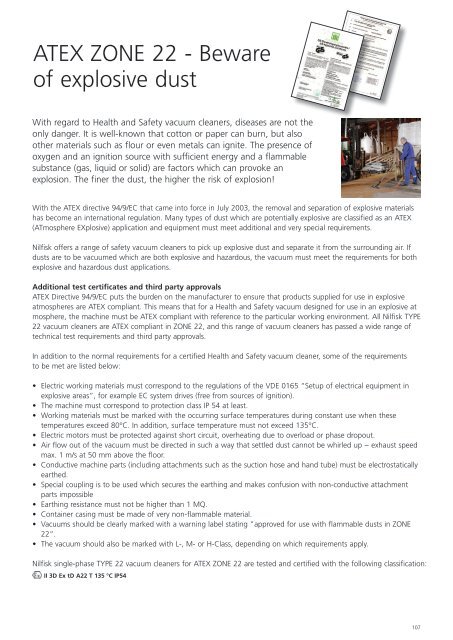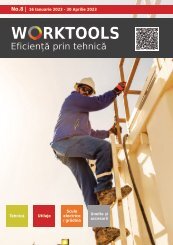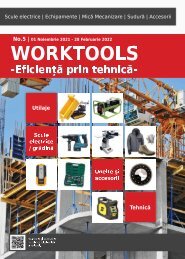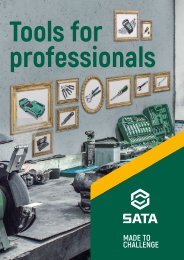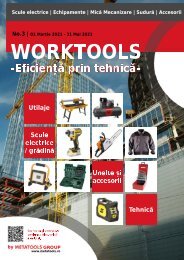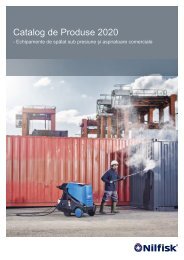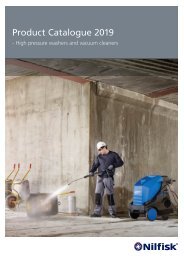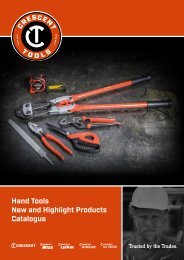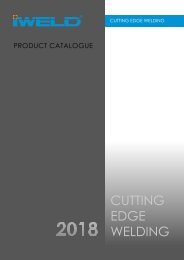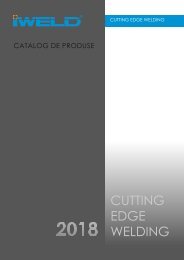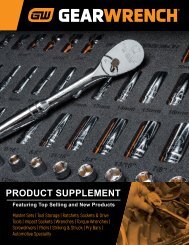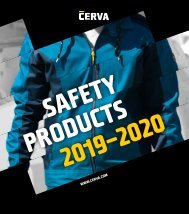Nilfisk - Catalogue - Grey Line - 2019 (EN)
You also want an ePaper? Increase the reach of your titles
YUMPU automatically turns print PDFs into web optimized ePapers that Google loves.
ATEX ZONE 22 - Beware<br />
of explosive dust<br />
With regard to Health and Safety vacuum cleaners, diseases are not the<br />
only danger. It is well-known that cotton or paper can burn, but also<br />
other materials such as flour or even metals can ignite. The presence of<br />
oxygen and an ignition source with sufficient energy and a flammable<br />
substance (gas, liquid or solid) are factors which can provoke an<br />
explosion. The finer the dust, the higher the risk of explosion!<br />
With the ATEX directive 94/9/EC that came into force in July 2003, the removal and separation of explosive materials<br />
has become an international regulation. Many types of dust which are potentially explosive are classified as an ATEX<br />
(ATmosphere EXplosive) application and equipment must meet additional and very special requirements.<br />
<strong>Nilfisk</strong> offers a range of safety vacuum cleaners to pick up explosive dust and separate it from the surrounding air. If<br />
dusts are to be vacuumed which are both explosive and hazardous, the vacuum must meet the requirements for both<br />
explosive and hazardous dust applications.<br />
Additional test certificates and third party approvals<br />
ATEX Directive 94/9/EC puts the burden on the manufacturer to ensure that products supplied for use in explosive<br />
atmospheres are ATEX compliant. This means that for a Health and Safety vacuum designed for use in an explosive at<br />
mosphere, the machine must be ATEX compliant with reference to the particular working environment. All <strong>Nilfisk</strong> TYPE<br />
22 vacuum cleaners are ATEX compliant in ZONE 22, and this range of vacuum cleaners has passed a wide range of<br />
technical test requirements and third party approvals.<br />
In addition to the normal requirements for a certified Health and Safety vacuum cleaner, some of the requirements<br />
to be met are listed below:<br />
• Electric working materials must correspond to the regulations of the VDE 0165 “Setup of electrical equipment in<br />
explosive areas”, for example EC system drives (free from sources of ignition).<br />
• The machine must correspond to protection class IP 54 at least.<br />
• Working materials must be marked with the occurring surface temperatures during constant use when these<br />
temperatures exceed 80°C. In addition, surface temperature must not exceed 135°C.<br />
• Electric motors must be protected against short circuit, overheating due to overload or phase dropout.<br />
• Air flow out of the vacuum must be directed in such a way that settled dust cannot be whirled up − exhaust speed<br />
max. 1 m/s at 50 mm above the floor.<br />
• Conductive machine parts (including attachments such as the suction hose and hand tube) must be electrostatically<br />
earthed.<br />
• Special coupling is to be used which secures the earthing and makes confusion with non-conductive attachment<br />
parts impossible<br />
• Earthing resistance must not be higher than 1 MQ.<br />
• Container casing must be made of very non-flammable material.<br />
• Vacuums should be clearly marked with a warning label stating "approved for use with flammable dusts in ZONE<br />
22”.<br />
• The vacuum should also be marked with L-, M- or H-Class, depending on which requirements apply.<br />
<strong>Nilfisk</strong> single-phase TYPE 22 vacuum cleaners for ATEX ZONE 22 are tested and certified with the following classification:<br />
II 3D Ex tD A22 T 135 °C IP54<br />
107


